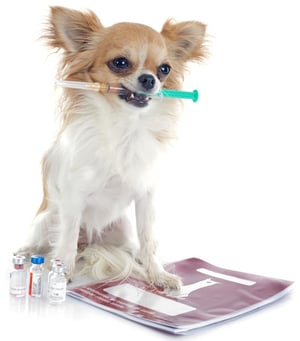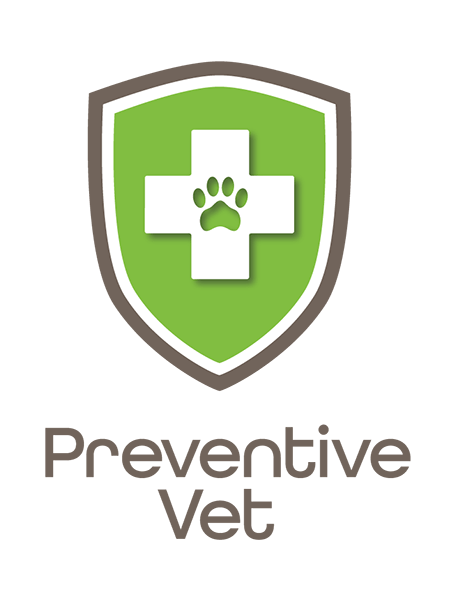- en
Your dog has just been diagnosed with a disease, and your veterinarian has said that it can be zoonotic – meaning you are at risk of getting sick. Now what?
This Pet InfoRx® explains what a zoonotic disease is, what ones are most common, and ways to protect yourself and others.
Quick Links

Do you ever wonder where a word comes from? Rudolph Virchow introduced the word zoonosis at the end of the nineteenth century to explain human diseases caused by animals. It is a combination of two Greek words. The word for animals is zoon, and the word for disease is noson.
Worldwide, there are over 150 zoonotic diseases – diseases transferred from animals, such as dogs and cats, livestock, birds, bats, and more. Of those 150 diseases, 13 are responsible for 2.2 million human deaths per year.
Our mission is to help save dogs' and cats’ lives through our educational content. To support our efforts, this page may contain affiliate links. We earn a commission for qualifying purchases – at no cost to you.
When any infection or disease is naturally transmitted from an animal to a human, it is referred to as a zoonosis. The infectious agent can be a bacteria, virus, fungi, or parasite.
The mode of transmission for zoonoses can be direct or via transmission of an intermediate species (a vector). With direct zoonosis, the disease is transmitted through the air or bites and saliva. Examples of these are influenza and rabies. If the zoonosis is transmitted via an intermediate species, that species just acts like a carrier of the disease but does not get sick. An example would be Lyme Disease from a tick.
Some zoonotic diseases are more common than others. Those that affect dogs, as well as humans, will be the main focus of this InfoRx. But it is important to realize that there are many others. If you travel, it is important to be aware of zoonotic diseases in the countries you visit.
Rabies is a virus that can infect almost all warm-blooded mammals. It primarily targets the nervous system and is transferred through saliva.
While rabies is rare in dogs and cats in the United States because of vaccines, it still exists because there are unvaccinated animals or there has been a lapse in their vaccination. It's very important to keep vaccines up to date – vaccinations are required by law in most (not all) states for dogs, cats, and some ferrets.
Rabies is typically divided into three phases. The first phase, the prodromal phase, is 2 to 3 days. During this phase, which often goes unnoticed, there are slight behavioral changes, fever, slower eye reflexes. The next phase is the furious phase, which lasts 2 to 4 days. Your dog will have erratic behaviors. This can include restlessness, aggression, irritability, barking, etc. The last phase is the paralytic phase. Your dog will show signs of weakness or paralysis in their legs, throat, facial muscles, etc. This is followed by depression, coma, and death. For dogs, death usually occurs within 3 to 7 days from the start of symptoms.
For people, rabies can cause highly fatal encephalitis in humans. Because there isn't an effective treatment, only a small number of people survive after being infected with this disease.
Leptospira, of which there are multiple strains, is a spiral-shaped bacteria that causes the infectious disease Leptospirosis. It can infect most wild and domestic animals. Humans can also be infected. Most cases of human infection in the United States result from recreational activities involving water. But infection from infected pets is possible as well.
The initial signs of infection are fever, lack of energy, and lack of appetite. Dogs may also have vomiting, lack of desire to move due to muscle pain, and dehydration. Infection can cause varying degrees of liver and renal disease.
People should use caution when handling any animals suspected of having Leptospirosis as well as handling their bedding and urine clean-up. The Leptospira bacteria is able to penetrate the lining of the mouth, nose, and eyelids. It can also enter the body through open sores and scratches in the skin.
Symptoms with human infection are flu-like and can cause kidney and liver disease.
Sarcoptic mange, which is caused by the Sarcoptes scabiei mite. They are a mite that burrows in the outermost layer of the skin, and they secrete allergenic substances that cause intense itching. It is a highly contagious, non-seasonal, intensely itchy skin disease.
Dogs are most commonly affected, but humans and cats can be as well. The pruritus (itchiness) and lesion are most severe around the face and underside of the body, but the elbows, hocks ("elbows" on the back legs), and ear flaps can also be affected.
Hookworms and roundworms are referred to as intestinal parasites.
Humans become infected by coming into contact with contaminated soil or feces. This occurs most often by walking barefoot in contaminated areas or by accidental ingestions of soil or feces. Adult hookworms do not infect humans. Humans are infected because the hookworm larva matures into a stage that can penetrate the skin. The worms will not mature into adults. They usually die within several weeks. The larva cause itching in the skin of humans. With roundworms, most often, humans are infected by accidentally swallowing soil or feces that is contaminated with eggs. Following ingestion, the worms can cause eye, heart, lung, or potentially neurologic signs in people.
Ringworm is a misleading term because the infection isn’t caused by a worm at all. The medical term for this common skin infection is dermatophytosis. The nickname “ringworm” comes from the circular, red, raised rash that resembles a worm in the shape of a ring. It’s caused by a fungus that feeds on the protein of the outer layer of hair, nails, and skin. This pesky infection is highly contagious. It can pass from animals to people and from people to animals.
Rabies is transmitted when saliva enters a deep wound, usually by a bite from an infected animal to another animal or human. Typical wild animals that can have rabies include skunks, raccoons, bats, and foxes.
The virus enters the peripheral nervous system and spreads to the spinal cord and brain. The time before symptoms occur is variable and can range from 2 to 8 weeks. Rabies can be present in the saliva for an extended period of time without an animal showing signs of the infection. Some animals have been known not to show symptoms for 6 months.

The bacteria that cause Leptospirosis lives in water or warm wet soil. It is most common in parts of the country that have warm climates and have high annual rainfall. But it can occur anywhere worldwide.
Leptospirosis can be transmitted in one of two ways:
It is a highly contagious disease – spreading from dog to dog very easily, as well as to humans. Typically, affected animals have a history of being in animal shelters, being in contact with stray dogs, or visiting either boarding or grooming facilities.
The disease is primarily transmitted by direct contact with the infected skin, but grooming instruments and kennels may harbor these mites.
This disease is treatable in both dogs and humans.
Typically, puppies are infected by their mother through the placenta or by their mother’s milk while nursing. Puppies and adult dogs can be infected by coming into contact with soil or dirt contaminated with larva or eggs. They can also become infected by grooming themselves following contact with infected soil. The soil can remain infective for weeks to months following the initial contamination.
Ringworm is highly contagious and happens when a pet or person comes in contact with another infected animal, person, or even surface. The fungus can live on skin, soil, surfaces, and other items such as clothing, brushes, towels, and bedding. If your pet is infected with ringworm, they remain contagious for about 3 weeks. Most adults with a healthy immune system are generally resistant to this infection. Children, however, can get ringworm not just from infected pets but other children and the outdoors. So, children, and those with compromised immune systems, should not handle a pet with ringworm.
A veterinary consultation is often needed to determine if a dog has a zoonotic disease. What you need to do once your pet is diagnosed will be determined by the specific cause of the zoonosis.
If your dog comes into contact and is potentially bitten by a wild animal, call your veterinarian immediately so they can instruct you on the proper course of action. If your dog has been vaccinated for Rabies, they will need to be re-vaccinated. If your dog has not had a Rabies vaccine, Animal Control will need to be contacted, and necessary guidelines will need to be followed. If you are bitten or come into contact with saliva from any potentially infected animal, seek medical attention immediately.
If your dog has a high fever, signs of acute renal failure (only producing a small amount to no urine), or acute liver failure (yellow gums or small reddish-purple spots on their gums or skin), you should use extreme caution in handling the pet and contact a veterinarian immediately. Be sure to use good hygiene and wear gloves. Consult with your veterinarian on how to properly disinfect your home, especially in areas where urine may be present. Dispose of any items that may be contaminated with urine.
Note: Normal activities with your pet do not put you at a higher risk of getting Leptospirosis. But direct or indirect contact with urine or blood from your dog while they are infected can increase your risks. It is best to consult with your doctor if you feel you are at an increased risk.
If your pet has been diagnosed with scabies/sarcoptic mange, isolate them from other pets and be sure to wear gloves when handling them and then shower and change clothes after finishing their care. Read more on how to care for your dog.
If you suspect that your puppy or adult dog has intestinal parasites, contact their veterinarian. They will request that you bring in a fresh poop sample – about 2 tablespoons. If the stool is loose or watery, ask them how they prefer you to collect it.
Proper decontamination of the environment you and your dog live in is important. While you cannot decontaminate the soil, all fecal matter must be picked up from the area. It is recommended that you not let your puppy or dog play in an area where they or other dogs go potty. Keep their play and potty areas separated.
If your dog has an outdoor pen, it could be contaminated. It is best to keep them out of the area and move the pen to a new location once they are parasite-free. If they stay on contaminated soil, they will likely become re-infected. If it is possible, placing outdoor pens on concrete allows for easier cleanup and disinfecting.
The chosen treatment plan from your veterinarian is based on the following:
If the infected area is very small or there only one to two locations, some veterinarians may recommend clipping the affected area(s) to prevent spreading infected fur into the environment and just applying an antifungal cream or ointment to the location. You should wear gloves when handling your dog and applying treatments. Treatment should be continued for one to two weeks after all lesions are gone.
For larger areas of infections, full-body clips may be recommended as well as antifungal shampoos (only use those recommended by your veterinarian). You will need to bathe your dog 2 to 3 times per week and be sure to leave the lather on for fifteen minutes before rinsing in lukewarm water. As a precaution, wearing gloves to bathe your pet is recommended, as is washing your hands afterward.
Many veterinarians will add oral anti-fungal medications for these more complicated cases. This is often the case if there was little to no success with localized, topical treatment, a large area is affected, multiple pets are involved, or if there are young or immunocompromised people in your home. Typically, treatment with oral anti-fungal medications lasts for a minimum of 6 weeks. There are cases where a longer time period is necessary. It is generally standard for there to be two-in-a-row negative ringworm culture tests before treatment is stopped.
Treatment will last anywhere from several weeks to months, depending on the severity of the infection and your dog’s response to treatment.
To help minimize spread, confine your dog, regardless of the severity of their infection, to a room that can easily be sanitized and is away from any other pets. Ideally, a room with a window so that the room can be aired out. If you do not have room to isolate your dog, an oversized crate will work as well. The whole idea is to keep fur and dandruff from spreading everywhere, so there's less to clean and disinfect, and it's easier to protect other pets and people in your home.
It is important to note that if treatment is stopped too early and proper environmental management is not done (see below), reinfection can occur.
The fungal spore can live in the environment for up to 18 months, so continue environmental sanitization for a period of time even after other treatments have stopped.
It is also important to sanitize your home after each bath and wherever your dog has spent time before diagnosis, as well as where they are confined to during quarantine. Diligently clean up and carefully remove all fur from all floors and furniture. Daily sweeping and vacuuming is recommended during the whole treatment period. Then damp mop the areas with a solution of chlorine bleach and water. This solution will kill the fungus.
To make a cleaning solution, dilute one pint of bleach in one gallon of water. In addition to damp mopping, wipe down all surfaces carefully. If possible, remove your dog from the room while it's airing out and the floor is drying.
Remember to wear gloves while sanitizing and wash your hands when done. Be sure to change your clothes and wash them as soon as you finish sanitizing or handling your dog.
If your dog has been vaccinated and re-vaccinated again following potential contact with a rabid animal, they should be fine. For dogs that weren't vaccinated, death usually occurs within 3 to 7 days from the start of symptoms.
With Leptospirosis, it will take a couple of weeks for significant improvement. Typically, your dog will be hospitalized during the time in order to be treated. But your veterinarian will inform you about improvements with their fever, dehydration, and bloodwork relating to liver and kidney values.
For sarcoptic mange, it may likely take about 14 days to see a significant decrease in itchiness and as long as 3 months for complete healing. Please note with sarcoptic mange; itchiness often worsens for the first few days. This is believed to be due to an immune response to the dying mites. Don't worry, things will get better.
The severity of the infection and the age of your pet determines how quickly you will see improvement. Things should improve over a 7 to 10 day period.
You will usually start to see improvement after about 2 to 3 weeks of treatment. The fur will begin to grow back, and the lesions will lessen.
With rabies, if there is any evidence of abnormal behavior or neurologic symptoms after potential exposure, contact your dog’s veterinarian and animal control immediately.
With Leptospirosis, your dog will be hospitalized at a veterinary clinic. Progression of liver and kidney failure and inability to control dehydration are unfavorable indicators for a successful recovery.
With sarcoptic mange, things you will notice if your dog is not improving include:
Improvements with this disease do not occur immediately in most cases. But if you do not see improvements within 7 to 10 days or notice any symptoms worsening, please contact your veterinarian. They may need to add or change your dog’s medications.
If either your puppy or adult dog continues to have diarrhea (especially 2 to 3 days beyond the beginning of treatment), appears to be constipated, their belly remains bloated, failure of gums to return to a healthy pink color, or they lose appetite or begin vomiting, contact your veterinarian promptly.
With ringworm, if your dog continues to get more lesions and has continued hair loss beyond the first two weeks of treatment, contact your veterinarian. It may be necessary to add or change medications (topical and/or anti-fungal). Additionally, your dog’s veterinarian may need to perform more diagnostic tests to ensure that no other health issues are affecting your dog’s immune system.


To protect your dog from rabies, be sure to have them vaccinated based on your state’s laws. The first vaccine is given at 4 months of age, then a booster shot a year later. Then, depending on your state's law, it is given yearly or every three years. Also, be sure that all other pets in your household are vaccinated. Avoid contact with any wildlife that can be potentially infected with rabies. Use caution around other domestic animals if you do not know their rabies vaccine status.
It is not a realistic expectation to prevent exposure to Leptospira. Therefore routine vaccination for leptospirosis is recommended. The main purpose of the vaccine is to reduce the incidence and severity of infection. Unfortunately, it does not prevent subclinical infection (i.e., when your dog isn't showing any signs of the disease but has it) or urine shedding. Do not allow your dog to drink from pools of stagnant water (puddles, ponds, bowls outside storefronts), and ideally, avoid letting them play or swim in lakes and ponds where there is a heavy wildlife population.
To prevent sarcoptic mange from re-occurring, be sure to keep your dog’s environment treated for parasites. Use the recommended preventative treatments for your dog – some topical and oral flea/tick treatments are also effective at preventing sarcoptic mange. Be sure to keep your dog away from stray dogs. And ask your groomer and boarding facility what their sanitation protocols are.
Lastly, with regards to sarcoptic mange, you may need to have your dog tested for allergies to dust mites because 30% of dogs will test positive for allergens to them. This may require your dog to have allergy treatments.
To prevent your pets from getting hookworms or roundworms, the following is recommended:
To protect yourself from infection with these parasites, do the following:
The best way to prevent ringworm from affecting your dog is to help support their immune system and diligently decontaminate their environment. Some ways to do this are as follows:
The Pet InfoRx® is made possible, in part, through our partnership with AlignCare®.


© Preventive Vet. All rights reserved. PreventiveVet.com
